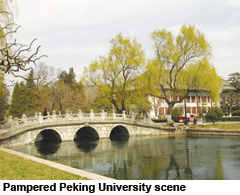Min Weifang, one of the 371 most powerful politicians in the country and former chair of council at Peking University, has called for greater academic freedom in some of the nation’s universities.
.gif) Earlier, in March, premier Wen Jiabao announced that this year China will finally meet its long-held aspiration to devote 4 percent of its gross domestic product (GDP) to education spending, against an average spend by countries of the Organisation for Economic Cooperation and Development (OECD) of 5.9 percent in 2008. This represents a victory for the country’s educators after nearly three decades of effort.
Earlier, in March, premier Wen Jiabao announced that this year China will finally meet its long-held aspiration to devote 4 percent of its gross domestic product (GDP) to education spending, against an average spend by countries of the Organisation for Economic Cooperation and Development (OECD) of 5.9 percent in 2008. This represents a victory for the country’s educators after nearly three decades of effort.
Yet even as ambitious top-tier universities close the gap with leading institutions abroad, senior academics have warned that the poor quality of China’s lowest-tier institutions and continuing limitations on academic freedom are holding back the sector’s ability to nurture creativity and innovation. And several international observers have noted the stark imbalance in state investment between elite and regional universities.
The 4 percent of GDP figure “is the number they (the government) have been trying to meet for 30 years. It indeed is a remarkable and important milestone,” says Min, who acquired postgraduate degrees in education and sociology at Stanford University and is currently director of Peking’s Institute of Economics of Education, as well as president of the Peking University Education Foundation.
 “(At Peking) we are coming closer and closer. We are now within the top 50. Probably in five years we will be in the top 30 — I don’t know. But personally speaking, I think we still have a long way to go to catch up with the very top universities like Cambridge, Oxford, Harvard and Stanford,” he adds.
“(At Peking) we are coming closer and closer. We are now within the top 50. Probably in five years we will be in the top 30 — I don’t know. But personally speaking, I think we still have a long way to go to catch up with the very top universities like Cambridge, Oxford, Harvard and Stanford,” he adds.
Min praises the country’s education funding strategy, which focuses millions of yuan on China’s top universities, often at the expense of poor regional varsities. But he acknowledges there is a long way to go for elite universities as well as for regional institutions, which, he suggests, have suffered from overzealous checks on academic freedoms and lack of funding.
Nevertheless, “a country like China cannot thinly spread out everything. Then you do nothing,” Min says, defending Peking and other top-tier institutions, including nearby Tsinghua University, as havens of comparative autonomy in a country where academics can be demoted, transferred to regional institutions, fired or detained for becoming too involved in politically sensitive areas.
In 2010, China spent 3.66 percent of GDP, or about 1.47 trillion yuan (Rs.1,249,5000 crore cf. India’s Rs.400,000 crore), on education. If that rises to 4 percent this year, and if growth in GDP hits the government target of 7.5 percent, education funding in 2012 could reach more than 2 trillion yuan (Rs.1,700,000 crore).
Although there is hope some of this extra money will go to addressing inequalities at regional universities, much of it seems likely to remain focused on the nation’s elite. For nearly two decades, China has been working to establish a group of world-class institutions, first with the “211” funding project for 100 universities established in 1994, and then in 1998 the more intensive “985” project, aimed at creating a sort of Chinese Ivy League, a group which now includes more than 30 institutions.
(Excerpted and adapted from Times Higher Education)